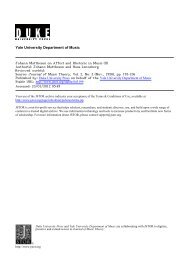Après une Lecture de Liszt: Virtuosity and ... - Free
Après une Lecture de Liszt: Virtuosity and ... - Free
Après une Lecture de Liszt: Virtuosity and ... - Free
Create successful ePaper yourself
Turn your PDF publications into a flip-book with our unique Google optimized e-Paper software.
19THCENTURYMUSICroad to Weimar amid the “most intense periodof anti-virtuosity backlash in the history ofinstrumental music,” 7 which in turn gave riseto a “strengthening forcefield between virtuosity<strong>and</strong> the work.” 8 If <strong>Liszt</strong> compared thevirtuoso’s career with a caterpillar’s confinement,did this disqualify “virtuosity” per se orwas it merely a response to public criticism?The comparison prompts another question thatcritics of many stripes have asked of authorshipwithin text- <strong>and</strong> score-based criticism:Who is speaking? 9 <strong>Liszt</strong>’s liquidation of hisperformer’s “self” testifies to his <strong>de</strong>sire to managehis public i<strong>de</strong>ntity strategically, to narratehis own story in a self-styled Künstlerroman,<strong>and</strong> thus to both publicize <strong>and</strong> legitimize hisnew i<strong>de</strong>ntity as a composer <strong>and</strong> ex-virtuoso. 10But as he entered into the service of a patronfor the first time in his professional career—not exactly the unfettered freedom of a butterfly—didthis transformation <strong>une</strong>quivocally representa <strong>de</strong>dicated commitment to a new causeor did it arise, at least in part, from his anxietyover the diminishing status of the virtuoso?In this article I would like to consi<strong>de</strong>r thesequestions in light of <strong>Liszt</strong>’s <strong>Après</strong> <strong>une</strong> lecturedu Dante: Fantasie quasi Sonata. Written between1839 <strong>and</strong> 1858, the Sonata survives inthree full manuscripts <strong>and</strong> four fragments <strong>and</strong>,I contend, interweaves hours <strong>and</strong> hours of improvisationwith a gradual process of revisionon a more abstracted, conceptual level. As apiece born expressly from acts of performance,the Sonata appears not to be regulated exclusivelyby the i<strong>de</strong>a that a work is an enduring,7Dana Gooley, The Virtuoso <strong>Liszt</strong> (Cambridge: CambridgeUniversity Press, 2004), p. 13. As Gooley observes, an antivirtuosostance was propoun<strong>de</strong>d by both Schumann’s NeueZeitschrift <strong>and</strong> Schlesinger’s Revue et Gazette musicale.8Jim Samson, <strong>Virtuosity</strong> <strong>and</strong> the Musical Work (Cambridge:Cambridge University Press, 2003), p. 74.9To cite two notable examples: Edward T. Cone, TheComposer’s Voice (Berkeley: University of California Press,1974), p. 1; Rol<strong>and</strong> Barthes, “The Death of the Author,” inImage—Music—Text, trans. Stephen Heath (Glasgow:Fontana/Collins, 1977), pp. 142–49.10Within the European press, <strong>Liszt</strong>’s compound nationalities,mobile class status, <strong>and</strong> musical competencies wereall <strong>de</strong>bated among writers <strong>and</strong> listeners as part of whatincreasingly became an unstable <strong>and</strong> over-<strong>de</strong>termined publici<strong>de</strong>ntity. See Gooley’s discussion of the multiple symbolici<strong>de</strong>ntities that <strong>Liszt</strong> fulfilled for his audiences in TheVirtuoso <strong>Liszt</strong>, pp. 2ff.immutable product. It thus subverts what CarolynAbbate calls the “performance network” inwhich performers more or less obey the centripetalforce of a “composed” work. 11 <strong>Liszt</strong>’spredisposition toward virtuosity ensured thatcertain musical i<strong>de</strong>as came to him through improvisationrather than prior to it. At first blushthis seems unsurprising, yet it nevertheless presentsa problem for the i<strong>de</strong>ology of a workconcept that separates <strong>Liszt</strong> hierarchicallyinto pianist <strong>and</strong> composer. In contrast to contemporarieslike Felix Men<strong>de</strong>lssohn or RobertSchumann, <strong>Liszt</strong> in his virtuosity continuallychallenges the aesthetic boundaries of composition,improvisation, <strong>and</strong> performance.Such categories imply a distinction betweenmusical thought in the physical immediacy ofimprovisation <strong>and</strong> musical thought in<strong>de</strong>pen<strong>de</strong>ntof physical enactment (even if the composerworks at the piano). But this distinctionappears increasingly weak in light of <strong>Liszt</strong>ianpractices that seemed to recognize a mutuallyinvertible relation between the fingers’ tactilediscovery of i<strong>de</strong>as at the keyboard <strong>and</strong> the cognitiongoverning those fingers <strong>and</strong> i<strong>de</strong>as. SirJohn Russell even reports that Beethoven continuedto improvise “tactilely” as late as 1821<strong>de</strong>spite being almost totally <strong>de</strong>af, 12 <strong>and</strong> in ourown time, research into brain activity has establisheda substantial anatomical overlap betweenexecuting <strong>and</strong> imaging motor tasks. 1311Carolyn Abbate, In Search of Opera (Princeton: PrincetonUniversity Press, 2001), pp. 9ff.12Russell’s account is reproduced in Oscar G. T. Sonneck,Beethoven: Impressions by His Contemporaries (New York:Dover, 1967), pp. 114–16.13Marc Jeannerod, “Neural Simulation of Action: A UnifyingMechanism for Motor Cognition,” NeuroImage 14(2001), 103–09; Marc Jeannerod, V. Frak, “Mental Imagingof Motor Activity in Humans,” Current Opinion in Neurobiology9 (2001), 735–39; M. Lotze, P. Montoya, M. Erb,E. Hulsmann, H. Flor, U. Klose, N. Birbaumer, W. Grodd,“Activation of Cortical <strong>and</strong> Cerebellar Motor Areas duringExecuted <strong>and</strong> Imagined H<strong>and</strong> Movements: An fMRI Study,”Journal of Cognitive Neuroscience 11 (1999), 491–501. Astudy specific to professional pianists suggests that, exceptin the primary sensorimotor area of the left hemisphere<strong>and</strong> the right cerebellum, playing music in one’shead <strong>and</strong> physically playing at the keyboard activate essentiallythe same cortical regions. There is, in other words,“a subliminal activation of the motor system in motorimagery.” See I. G. Meister, T. Krings, H. Foltys, B.Boroojerdi, M. Müller, R. Töpper, A. Thron, “Piano Playingin the Mind—an fMRI Study on Music Imagery <strong>and</strong>Performance in Pianists,” Cognitive Brain Research 1954



